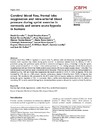Please use this identifier to cite or link to this item:
https://accedacris.ulpgc.es/jspui/handle/10553/41810
| Title: | Cerebral blood flow, frontal lobe oxygenation and intra-arterial blood pressure during sprint exercise in normoxia and severe acute hypoxia in humans | Authors: | Curtelin Pérez, David Morales-Alamo, David Torres-Peralta, Rafael Rasmussen, Peter Martín Rincón, Marcos Pérez Valera, Mario Siebenmann, Christoph Pérez-Suárez, Ismael Cherouveim, Evgenia Sheel, A. William Lundby, Carsten Calbet, Jose A. L. |
UNESCO Clasification: | 241106 Fisiología del ejercicio | Keywords: | Exercise High altitude Hypertension Cerebral blood flow Cerebral haemodynamics |
Issue Date: | 2018 | Project: | Oxygenación Cerebral y Fatiga Durante El Ejercicio en Hipoxia Aguda | Journal: | Journal of Cerebral Blood Flow and Metabolism | Abstract: | Cerebral blood flow (CBF) is regulated to secure brain O-2 delivery while simultaneously avoiding hyperperfusion; however, both requisites may conflict during sprint exercise. To determine whether brain O-2 delivery or CBF is prioritized, young men performed sprint exercise in normoxia and hypoxia (PIO2=73mmHg). During the sprints, cardiac output increased to similar to 22 Lmin(-1), mean arterial pressure to similar to 131mmHg and peak systolic blood pressure ranged between 200 and 304mmHg. Middle-cerebral artery velocity (MCAv) increased to peak values (similar to 16%) after 7.5s and decreased to pre-exercise values towards the end of the sprint. When the sprints in normoxia were preceded by a reduced PETCO2, CBF and frontal lobe oxygenation decreased in parallel (r=0.93, P<0.01). In hypoxia, MCAv was increased by 25%, due to a 26% greater vascular conductance, despite 4-6mmHg lower PaCO2 in hypoxia than normoxia. This vasodilation fully accounted for the 22 % lower CaO2 in hypoxia, leading to a similar brain O-2 delivery during the sprints regardless of PIO2. In conclusion, when a conflict exists between preserving brain O-2 delivery or restraining CBF to avoid potential damage by an elevated perfusion pressure, the priority is given to brain O-2 delivery. | URI: | https://accedacris.ulpgc.es/handle/10553/41810 | ISSN: | 0271-678X | DOI: | 10.1177/0271678X17691986 | Source: | Journal of Cerebral Blood Flow and Metabolism [ISSN 0271-678X], v. 38 (1), p. 136-150 |
| Appears in Collections: | Artículos |
SCOPUSTM
Citations
60
checked on Jun 8, 2025
WEB OF SCIENCETM
Citations
54
checked on Jun 8, 2025
Page view(s)
118
checked on Aug 10, 2024
Download(s)
299
checked on Aug 10, 2024
Google ScholarTM
Check
Altmetric
Share
Export metadata
Items in accedaCRIS are protected by copyright, with all rights reserved, unless otherwise indicated.
